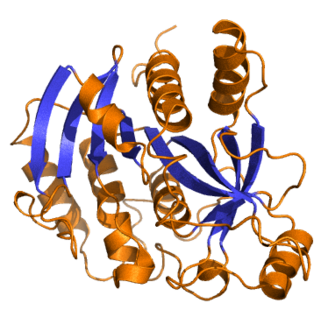
Apyrase is a calcium-activated plasma membrane-bound enzyme that catalyses the hydrolysis of ATP to yield AMP and inorganic phosphate. Two isoenzymes are found in commercial preparations from S. tuberosum. One with a higher ratio of substrate selectivity for ATP:ADP and another with no selectivity.

Succinyl coenzyme A synthetase is an enzyme that catalyzes the reversible reaction of succinyl-CoA to succinate. The enzyme facilitates the coupling of this reaction to the formation of a nucleoside triphosphate molecule from an inorganic phosphate molecule and a nucleoside diphosphate molecule. It plays a key role as one of the catalysts involved in the citric acid cycle, a central pathway in cellular metabolism, and it is located within the mitochondrial matrix of a cell.

Purine nucleoside phosphorylase, PNP, PNPase or inosine phosphorylase is an enzyme that in humans is encoded by the NP gene. It catalyzes the chemical reaction

Caldesmon is a protein that in humans is encoded by the CALD1 gene.

Deoxycytidine kinase (dCK) is an enzyme which is encoded by the DCK gene in humans. dCK predominantly phosphorylates deoxycytidine (dC) and converts dC into deoxycytidine monophosphate. dCK catalyzes one of the initial steps in the nucleoside salvage pathway and has the potential to phosphorylate other preformed nucleosides, specifically deoxyadenosine (dA) and deoxyguanosine (dG), and convert them into their monophosphate forms. There has been recent biomedical research interest in investigating dCK's potential as a therapeutic target for different types of cancer.

Ectonucleotidases consist of families of nucleotide metabolizing enzymes that are expressed on the plasma membrane and have externally oriented active sites. These enzymes metabolize nucleotides to nucleosides. The contribution of ectonucleotidases in the modulation of purinergic signaling depends on the availability and preference of substrates and on cell and tissue distribution.

Ectonucleoside triphosphate diphosphohydrolase-1 also known as CD39, is a typical cell surface enzyme with a catalytic site on the extracellular face.

ENOX2 is a gene located on the long arm of the X chromosome in humans. The gene encodes the protein Ecto-NOX disulfide-thiol exchanger 2, a member of the NOX family of NADPH oxidases.

Inosine triphosphate pyrophosphatase is an enzyme that in humans is encoded by the ITPA gene, by the rdgB gene in bacteria E.coli and the HAM1 gene in yeast S. cerevisiae; the protein is also encoded by some RNA viruses of the Potyviridae family. Two transcript variants encoding two different isoforms have been found for this gene. Also, at least two other transcript variants have been identified which are probably regulatory rather than protein-coding.

Ectonucleoside triphosphate diphosphohydrolase 6 is an enzyme that in humans is encoded by the ENTPD6 gene.

Isocitrate dehydrogenase [NAD] subunit gamma, mitochondrial is an enzyme that in humans is encoded by the IDH3G gene.

Ectonucleoside triphosphate diphosphohydrolase 2 is an enzyme that in humans is encoded by the ENTPD2 gene.

CANT1 is a gene that encodes soluble calcium-activated nucleotidase 1, an enzyme, in humans.

ATPase inhibitor, mitochondrial is an enzyme that in humans is encoded by the ATPIF1 gene.

Ectonucleoside triphosphate diphosphohydrolase 5 is an enzyme that in humans is encoded by the ENTPD5 gene.

Myosin-4 also known as myosin, heavy chain 4 is a protein which in humans is encoded by the MYH4 gene.

Herbert Zimmermann is a German neuroscientist who pioneered the studies on the biochemical, structural and functional heterogeneity of cholinergic synaptic vesicles from the electric organ of the electric ray Torpedo, and the functional and biochemical characterization of enzymes hydrolyzing extracellular nucleotides.

Ectonucleoside triphosphate diphosphohydrolase 4 is a protein that in humans is encoded by the ENTPD4 gene.

Ectonucleoside triphosphate diphosphohydrolase 7 is a protein that in humans is encoded by the ENTPD7 gene.

Arterial calcification due to CD73 deficiency or Calcification of joints and arteries is a rare genetic disorder affecting adults.






















